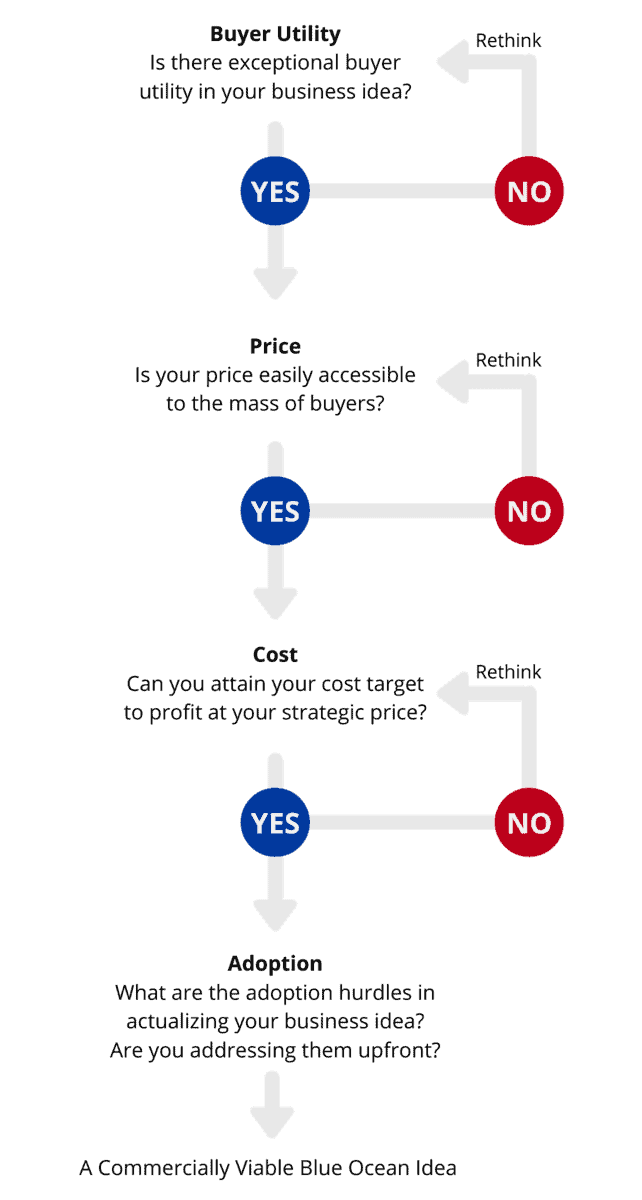-
 Red Ocean vs Blue Ocean Strategy
Red Ocean vs Blue Ocean Strategy
-
 Value Innovation
Value Innovation
-
 Strategy Canvas
Strategy Canvas
-
 Buyer Utility Map
Buyer Utility Map
-
 Three Tiers of Noncustomers
Three Tiers of Noncustomers
-
 Six Paths Framework
Six Paths Framework
-
 Four Actions Framework
Four Actions Framework
-
 ERRC Grid
ERRC Grid
-
 Pioneer Migrator Settler Map
Pioneer Migrator Settler Map
-
 Price Corridor of the Mass
Price Corridor of the Mass
-
 Sequence of Creating a Blue Ocean
Sequence of Creating a Blue Ocean
-
 Five Steps to a Blue Ocean Shift
Five Steps to a Blue Ocean Shift
-
 Three Components of Blue Ocean Shift
Three Components of Blue Ocean Shift
-
 Three Components of Humanness
Three Components of Humanness
-
 Four Hurdles to Strategy Execution
Four Hurdles to Strategy Execution
-
 Fair Process
Fair Process
-
 Tipping Point Leadership
Tipping Point Leadership
-
 Blue Ocean Vs Conventional Leadership
Blue Ocean Vs Conventional Leadership
-
 Leadership Canvas
Leadership Canvas
-
 Blue Ocean Leadership Grid
Blue Ocean Leadership Grid
-
 Four-Step Blue Ocean Leadership Process
Four-Step Blue Ocean Leadership Process
-
 Cost of Disengaged Employees
Cost of Disengaged Employees
SEQUENCE OF CREATING A BLUE OCEAN
Companies need to build their blue ocean strategy in the sequence of buyer utility, price, cost, and adoption. This allows them to build a viable business model and ensure that a company profits from the blue ocean it is creating.
Chan Kim and Renée Mauborgne argue that with an understanding of the right strategic sequence and of how to assess blue ocean ideas against the key criteria in that sequence, companies can dramatically reduce business model risk and ensure that both the company and its customers win as it creates new business terrain.

© Chan Kim & Renée Mauborgne. All rights reserved.
Here Chan Kim and Renée Mauborgne articulate the strategic sequence of creating a commercially viable blue ocean idea.
The starting point is buyer utility. Does your offering unlock exceptional utility? Is there a compelling reason for the mass of people to buy it?
Second, is your offering priced to attract the mass of target buyers so that they have a compelling ability to pay for your offering? If it is not, they cannot buy it. Nor will the offering create irresistible market buzz.
The first two steps address the revenue side of a company’s business model. They ensure that you create a leap in net buyer value. To secure the profit side you need to assess the third element: cost. The cost side of a company’s business model ensures that it creates a leap in value for itself in the form of profit—that is, the price of the offering minus the cost of production. The key question here is: Can you produce your offering at the target cost and still earn a healthy profit margin? You should not let costs drive prices. Nor should you scale down utility because high costs block your ability to profit at the strategic price. When the target cost cannot be met, you must either forgo the idea because the blue ocean won’t be profitable, or you must innovate your business model to hit the target cost.
The last step in the sequence is to address adoption hurdles. What are the adoption hurdles in rolling out your idea? Have you addressed these up front? The formulation of blue ocean strategy is complete only when you can address adoption hurdles in the beginning to ensure the successful actualization of your idea.
-
 Red Ocean vs Blue Ocean Strategy
Red Ocean vs Blue Ocean Strategy
-
 Value Innovation
Value Innovation
-
 Strategy Canvas
Strategy Canvas
-
 Buyer Utility Map
Buyer Utility Map
-
 Three Tiers of Noncustomers
Three Tiers of Noncustomers
-
 Six Paths Framework
Six Paths Framework
-
 Four Actions Framework
Four Actions Framework
-
 ERRC Grid
ERRC Grid
-
 Pioneer Migrator Settle Map
Pioneer Migrator Settle Map
-
 Price Corridor of the Mass
Price Corridor of the Mass
-
 Sequence of Creating a Blue Ocean
Sequence of Creating a Blue Ocean
-
 Five Steps to a Blue Ocean Shift
Five Steps to a Blue Ocean Shift
-
 Three Components of Blue Ocean Shift
Three Components of Blue Ocean Shift
-
 Three Components of Humanness
Three Components of Humanness
-
 Four Hurdles to Strategy Execution
Four Hurdles to Strategy Execution
-
 Fair Process
Fair Process
-
 Tipping Point Leadership
Tipping Point Leadership
-
 Blue Ocean Vs Conventional Leadership
Blue Ocean Vs Conventional Leadership
-
 Leadership Canvas
Leadership Canvas
-
 Blue Ocean Leadership Grid
Blue Ocean Leadership Grid
-
 Four-Step Blue Ocean Leadership Process
Four-Step Blue Ocean Leadership Process
-
 Cost of Disengaged Employees
Cost of Disengaged Employees

BLUE OCEAN SPRINT with AI NAVIGATOR
Kickstart Your Growth, Break Free from Competition, and Redefine Your Market to Seize New Opportunities
Leverage the new AI Navigator, your superpowered Blue Ocean-trained partner in strategy and put it to work for your business.
“LOVED this course. No nonsense, 100% practical tools I can start implementing TODAY in my organisation!” Amalia C., Google
THE BLUE OCEAN STRATEGY PRACTITIONER PROGRAM

Transform your strategic perspective, master blue ocean tools and frameworks, & learn to unlock new growth opportunities
Get started with new market creation with our live, interactive, expert-led program.